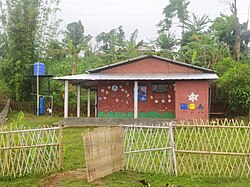1950s to 1990s
Langpih is the subject of a long-running dispute between the Meghalaya and Assam state governments, one of twelve such disputed territories. [8] According to Meghalaya Chief Minister Donkapur Roy, the British annexed the village to Assam's Kamrup district, but then after Indian independence, it was assigned to the United Khasi and Jaintia Hills district, a district in today's Meghalaya state. [4] The Meghalaya government claims that Assam's 1951 demarcation shows the area as part of a district in what would later become Meghalaya state. However, in 1972, Assam's new demarcation showed the area as part of its own Mikir Hills district (now Karbi Anglong District). [11]
In 1974, government forces from the two states had a faceoff in the village after Meghalaya policemen allegedly expelled Nepalese grazers, leading Assam policemen to arrive and investigate. [12] Link magazine described the situation as "explosive". [13] Hopingstone Lyngdoh claims that Assam "encroached on the village in 1979" and since then encouraged further Assamese settlement there. [10] In 1988, it was claimed in the Lok Sabha that the government of Meghalaya had proposed to set up an electoral constituency, 34-Nongstoin, which covered Kamphaduli, Hakumari, and Langpih. [1]
2010s
The Langpih Incident occurred on 14 May 2010, when clashes broke out between the Nepalese and tribal Khasi people, leading to shootings by police. [14] National media reported that four Khasi villagers died of the gunshot wounds: Columbus Hujon, Charles Lyngkhoi, Dennis Nonsiej, and Ekros Rani. Reports of the total number of injured varied between twelve and twenty-six. [15] [16] The governments of Assam and Meghalaya have each reported the death toll as two; even this death toll has become an object of political controversy, with authorities of each state moving the corpses around across state borders to manipulate the number. [3] A monument was constructed in memory of the dead villagers. [15]
Repercussions of the 2010 incident continued to be felt in 2012, when Pynskhemlang Nongshlong of neighbouring Rambrai village planned to lead a hunger strike in memory of the four slain men. [15] Nongshlong and thirteen fellow activists took to a stage constructed by local people specially for their fast. Two hours after the fast began, the Assistant District Commissioner of Kamrup and 150 police of Assam State arrived at the site. However, Langpih villagers formed a human chain to deny access to police. [17] By the eighth day, eight of the fasters had been retired to Shillong Civil Hospital due to ill health; Nongshlong and five others remained, but were clearly suffering from the effects of dehydration. [18] As the fast neared its second week, Meghalaya Chief Minister Mukul Sangma appealed to Delhi for assistance. [19]
Nongshlong declared an end to the fast on 13 July, giving the government a deadline of two months to fulfill a list of demands which the villagers would later announce. [20] [21] However, on 16 July Nongshlong and four women resumed their fast at Nongstoin. [22] Around the same time, the Meghalaya People’s Human Rights Council sent a delegation to the 20th Session of the United Nations Human Rights Council in Geneva, Switzerland. MPHRC General Secretary Dino Dympep met with UN Special Rapporteur James Anaya regarding the 2010 killings, following which Anaya sent a communique to the Government of India. However, by the following month the GOI had failed to respond. [23]


